Growing up, adobo was the first dish my lola taught me to cook, and I'll never forget the way she'd guide my hands as I balanced the vinegar and soy sauce. "Lasa lang," she'd say (just taste). Years later, when I moved away from home and craved that familiar comfort, I found myself making this fish version more than any other dish.
This Adobong Isda recipe has saved me countless weeknight dinners and impressed more friends than I can count. It's forgiving enough for beginners but delivers the deep, complex flavors that make Filipino food so special.
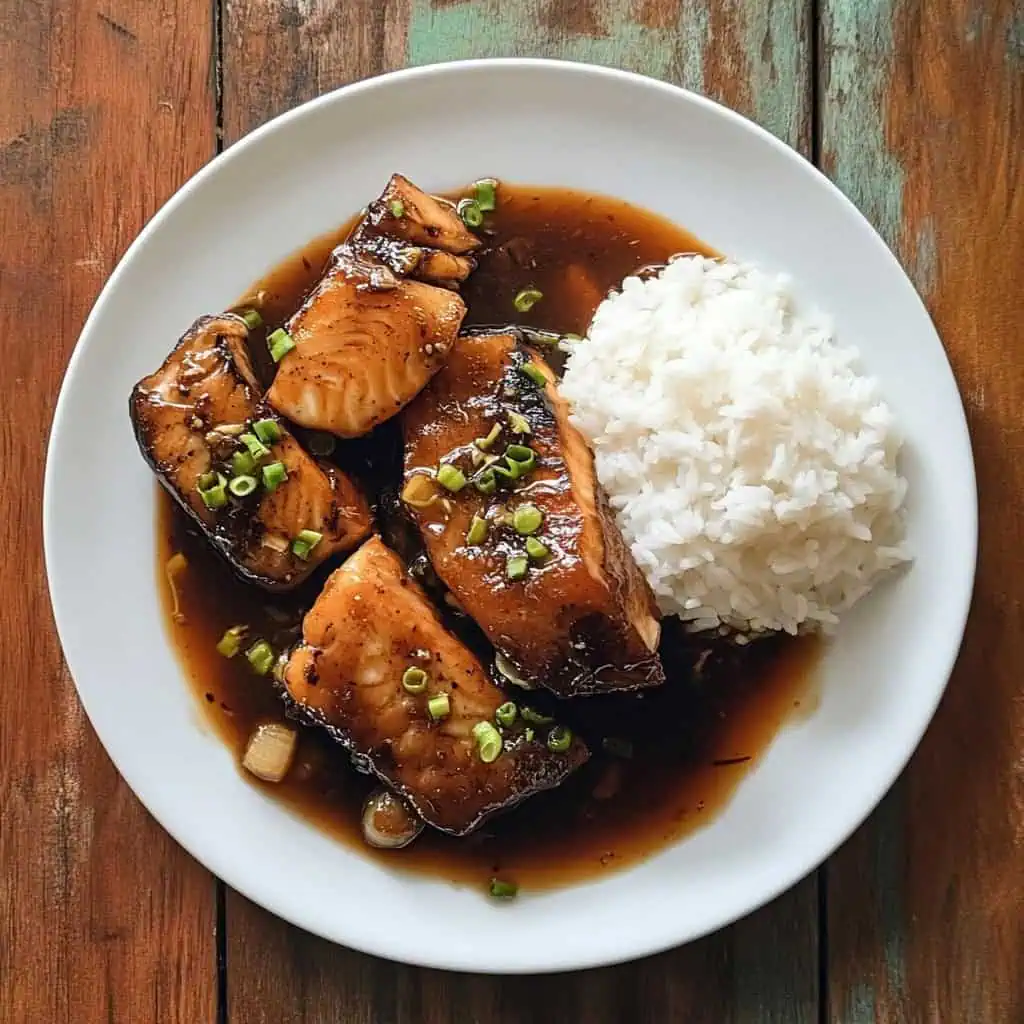
Why You'll Love This Recipe
This Adobong Isda will become your go-to seafood dish because it's incredibly forgiving and packed with bold flavors that satisfy every craving. The beautiful balance of salty soy sauce, tangy vinegar, and aromatic spices creates a sauce so good you'll want to drizzle it over everything.
Unlike other fish recipes that can be tricky, this adobo method keeps the fish moist and flaky while infusing it with deep, complex flavors. Plus, it's a complete meal when served over steamed rice, and the leftovers taste even better the next day!
Jump to:
Ingredients
- 1 medium-sized fish (about 1-2 lbs), cleaned and sliced into steaks
- 4 cloves garlic, peeled and minced
- ¼ cup white vinegar
- ¼ cup soy sauce
- 1 teaspoon whole black peppercorns
- 1 cup water
- 4-5 pieces bay leaves
- 1 red chili pepper (optional)
- 3 tablespoons cooking oil
- 1-2 teaspoons sugar (to taste)
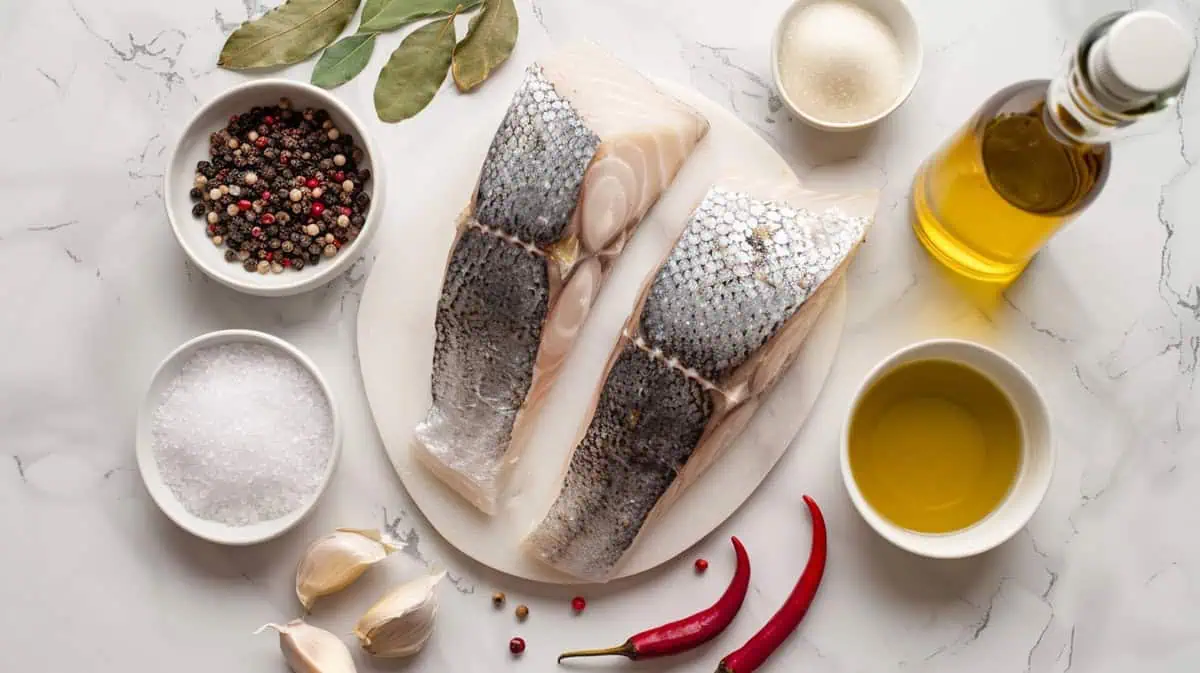
These ingredients work together to create the perfect adobo balance. The vinegar provides the signature tang that Filipino adobo is known for, while the soy sauce adds umami depth and beautiful color.
Garlic and bay leaves build the aromatic foundation, and the peppercorns give a gentle heat that complements the fish beautifully. The small amount of sugar helps round out the flavors and reduces any harsh acidity.
Equipment
- Large saucepan or Dutch oven - Essential for braising the fish evenly and allowing the sauce to reduce properly without overcrowding
- Sharp knife - For mincing garlic and slicing the fish into even portions for uniform cooking
- Cutting board - Provides a stable surface for prep work and keeps your counters clean
- Wooden spoon or spatula - Perfect for gently turning the fish without breaking the delicate flesh
- Serving platter - For presenting your beautiful adobo fish family-style
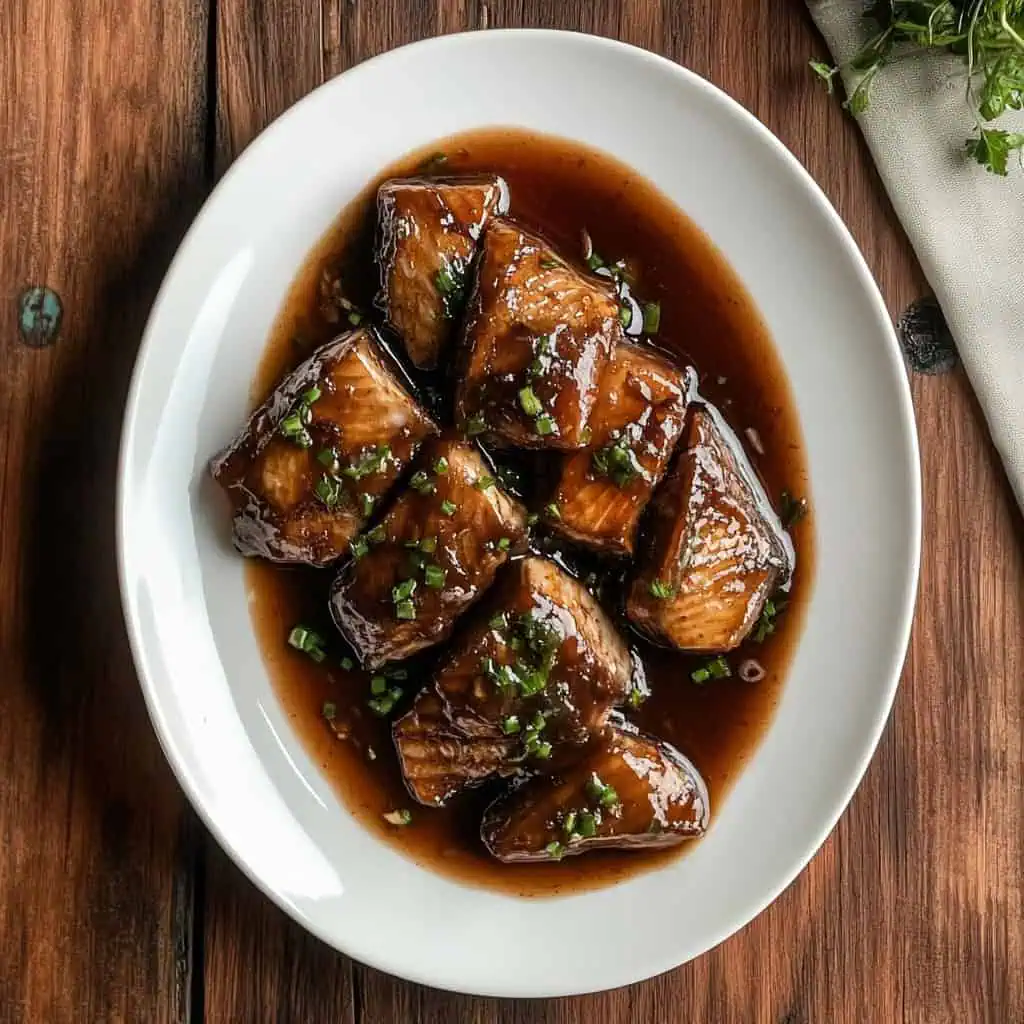
How To Make
- Heat your large saucepan over medium heat and add all ingredients except the cooking oil and sugar. The beauty of adobo is that everything goes into one pot, making cleanup a breeze. Pour in the vinegar, soy sauce, and water, then nestle the fish pieces in the liquid along with the minced garlic, bay leaves, and peppercorns. If you're using the chili pepper, add it now for a gentle kick of heat.
- Bring the mixture to a rolling boil over medium heat, which should take about 5-7 minutes. You'll start to smell the amazing aroma of the garlic and bay leaves mixing with the tangy vinegar. Once boiling, taste the liquid and add sugar gradually until you achieve the perfect balance of salty, sour, and slightly sweet flavors that makes adobo so addictive.
- Reduce the heat to low and let the fish simmer gently for 30 minutes. This slow cooking process allows the fish to absorb all those wonderful flavors while the sauce reduces and thickens into liquid gold. About halfway through the cooking time, carefully turn each piece of fish over using your wooden spoon to ensure even cooking and flavor absorption on both sides.
- Continue simmering until the fish flakes easily with a fork and the sauce has thickened to a glossy, rich consistency that coats the back of your spoon. The liquid should have reduced by about half, concentrating all those beautiful flavors. Remove the bay leaves before serving, then carefully transfer the fish and sauce to your serving platter.
- Serve immediately over steamed white rice, making sure to spoon plenty of that incredible sauce over everything. The rice will soak up the adobo sauce, creating the perfect bite every time.

Tips from Lola's Kitchen
- Choose firm fish like tanguige, mackerel, or salmon that won't fall apart during the long simmering process
- Don't stir the fish too much while cooking - gentle turning prevents the pieces from breaking
- Let the adobo rest for 10 minutes after cooking to allow the flavors to settle and the sauce to thicken further
- Start with less sugar and add more to taste - you can always add more but you can't take it away
- Use a wide, shallow pan if possible to give the fish more surface contact with the flavorful liquid
- Save some of the cooking liquid to drizzle over rice - it's pure flavor gold
Substitutions
- Fish varieties: Salmon steaks, bangus (milkfish), tilapia, or any firm white fish work beautifully
- Vinegar options: Cane vinegar, rice vinegar, or apple cider vinegar can replace white vinegar
- Soy sauce alternatives: Use low-sodium soy sauce and adjust salt levels, or try coconut aminos for a gluten-free option
- No bay leaves: Substitute with 1 teaspoon dried oregano or skip entirely
- Fresh chili: Dried red pepper flakes or cayenne powder work in a pinch
- Sugar substitute: Honey, brown sugar, or coconut sugar add different flavor notes
Troubleshooting
- Fish falling apart: Choose firmer fish varieties and handle gently when turning
- Sauce too salty: Add more water and a pinch of sugar to balance the flavors
- Too sour: Increase sugar gradually or add a splash more soy sauce
- Sauce not thickening: Remove the lid and increase heat slightly to encourage evaporation
- Fish overcooked: Reduce cooking time to 20-25 minutes for thinner fish pieces
- Bland flavor: Add more garlic, an extra bay leaf, or a splash more vinegar
Storage & Reheating
- Refrigerator: Store covered for up to 3 days - the flavors actually improve overnight
- Freezer: Freeze for up to 2 months in airtight containers, though texture may change slightly
- Reheating: Warm gently on stovetop over low heat to prevent fish from becoming tough
- Microwave option: Heat in 30-second intervals, stirring gently between sessions
- Serving leftover: Cold adobo fish makes an excellent filling for sandwiches or salads
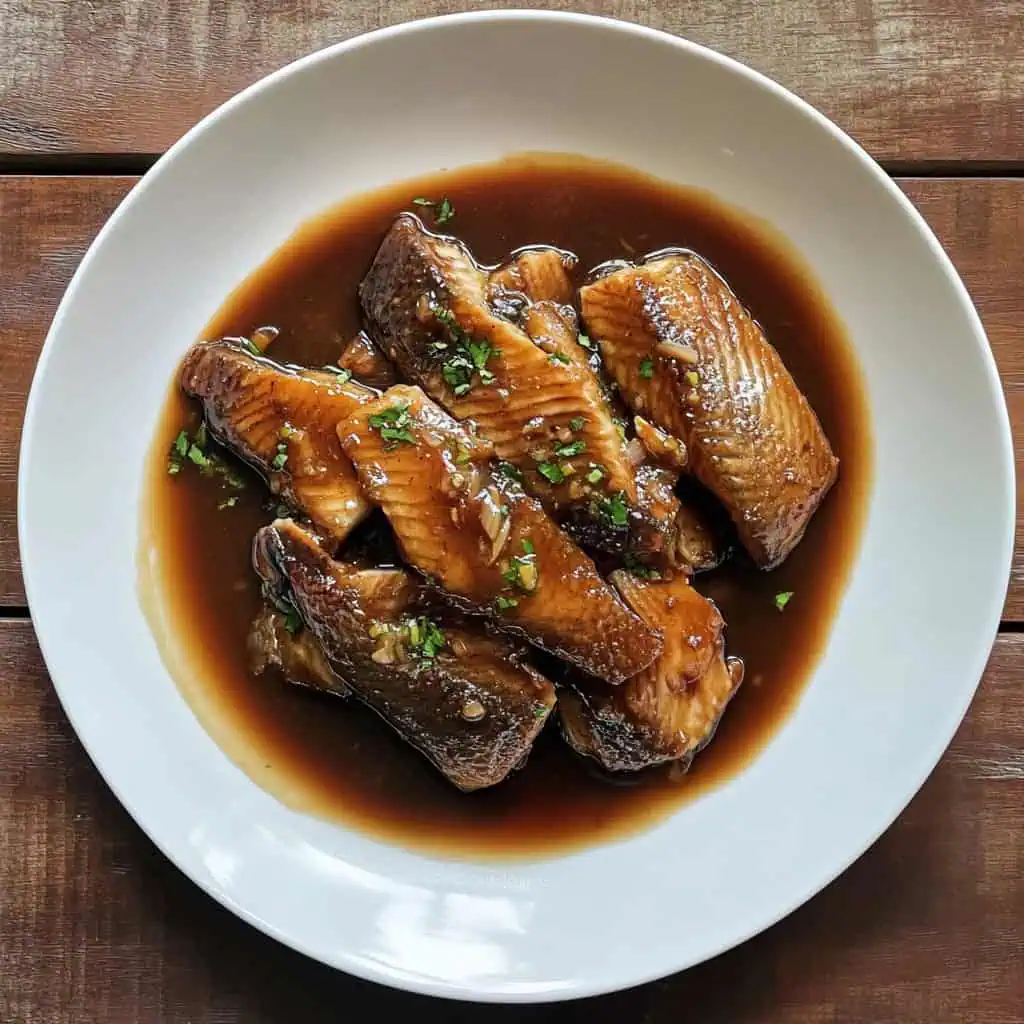
FAQ
Can I use frozen fish?
Yes, just thaw completely and pat dry before cooking to prevent excess water in the sauce
How do I know when the fish is done?
The flesh should flake easily with a fork and be opaque throughout
Can I make this ahead?
Absolutely! Adobo tastes even better the next day as flavors continue to develop
What rice goes best?
Plain jasmine or long-grain white rice lets the adobo flavors shine
Is this dish spicy?
Only if you add the chili pepper - without it, there's just gentle warmth from the peppercorns
Can I double the recipe?
Yes, just use a larger pot and extend cooking time by 10-15 minutes if needed
What vegetables pair well?
Steamed bok choy, green beans, or a simple cucumber salad complement the rich flavors perfectly
Related
Looking for other recipes like this? Try these:

Adobong Isda (Fish Adobo)
Ingredients
- 1 medium-sized fish about 1-2 lbs, cleaned and sliced into steaks
- 4 cloves garlic peeled and minced
- ¼ cup white vinegar
- ¼ cup soy sauce
- 1 teaspoon whole black peppercorns
- 1 cup water
- 4-5 pieces bay leaves
- 1 red chili pepper optional
- 3 tablespoons cooking oil
- 1-2 teaspoons sugar to taste
Instructions
- Heat your large saucepan over medium heat and add all ingredients except the cooking oil and sugar. The beauty of adobo is that everything goes into one pot, making cleanup a breeze. Pour in the vinegar, soy sauce, and water, then nestle the fish pieces in the liquid along with the minced garlic, bay leaves, and peppercorns. If you're using the chili pepper, add it now for a gentle kick of heat.
- Bring the mixture to a rolling boil over medium heat, which should take about 5-7 minutes. You'll start to smell the amazing aroma of the garlic and bay leaves mixing with the tangy vinegar. Once boiling, taste the liquid and add sugar gradually until you achieve the perfect balance of salty, sour, and slightly sweet flavors that makes adobo so addictive.
- Reduce the heat to low and let the fish simmer gently for 30 minutes. This slow cooking process allows the fish to absorb all those wonderful flavors while the sauce reduces and thickens into liquid gold. About halfway through the cooking time, carefully turn each piece of fish over using your wooden spoon to ensure even cooking and flavor absorption on both sides.
- Continue simmering until the fish flakes easily with a fork and the sauce has thickened to a glossy, rich consistency that coats the back of your spoon. The liquid should have reduced by about half, concentrating all those beautiful flavors. Remove the bay leaves before serving, then carefully transfer the fish and sauce to your serving platter.
- Serve immediately over steamed white rice, making sure to spoon plenty of that incredible sauce over everything. The rice will soak up the adobo sauce, creating the perfect bite every time.
Tips from Lola's Kitchen
- Choose firm fish like tanguige, mackerel, or salmon that won't fall apart during the long simmering process
- Don't stir the fish too much while cooking - gentle turning prevents the pieces from breaking
- Let the adobo rest for 10 minutes after cooking to allow the flavors to settle and the sauce to thicken further
- Start with less sugar and add more to taste - you can always add more but you can't take it away
- Use a wide, shallow pan if possible to give the fish more surface contact with the flavorful liquid
- Save some of the cooking liquid to drizzle over rice - it's pure flavor gold
The Story Behind Adobong Isda
Adobo holds the crown as the Philippines' unofficial national dish, and for good reason. This cooking method arrived in the islands long before Spanish colonization, when early Filipinos discovered that braising meat and fish in vinegar and salt created incredibly flavorful dishes that lasted longer in the tropical heat. The natural acidity of vinegar acted as a preservative, making it essential for survival in a time before refrigeration.
When Spanish colonizers arrived in the 16th century, they recognized similarities between this indigenous cooking technique and their own "adobar" method of preserving meat. The Spanish word "adobo" stuck, but the cooking method remained purely Filipino. Over centuries, each region developed its own variations, with coastal communities naturally gravitating toward fish and seafood versions that showcased their abundant marine resources.
Adobong Isda represents the perfect marriage of necessity and flavor that defines Filipino cuisine. Fishing communities along the Philippines' 7,641 islands created this dish as a way to make their daily catch last longer while infusing it with bold, satisfying flavors. The addition of soy sauce came later through Chinese trade influences, creating the perfect balance of salty, sour, and umami that makes modern adobo so irresistible.
Today, Adobong Isda remains a staple in Filipino households because it transforms affordable, readily available fish into something extraordinary. Every family has their own secret touches – some add coconut milk for richness, others include pineapple for sweetness, and many adjust the vinegar-to-soy-sauce ratio based on regional preferences. This flexibility has allowed the dish to evolve while maintaining its essential character, making it both a link to Filipino heritage and a canvas for personal expression in the kitchen.
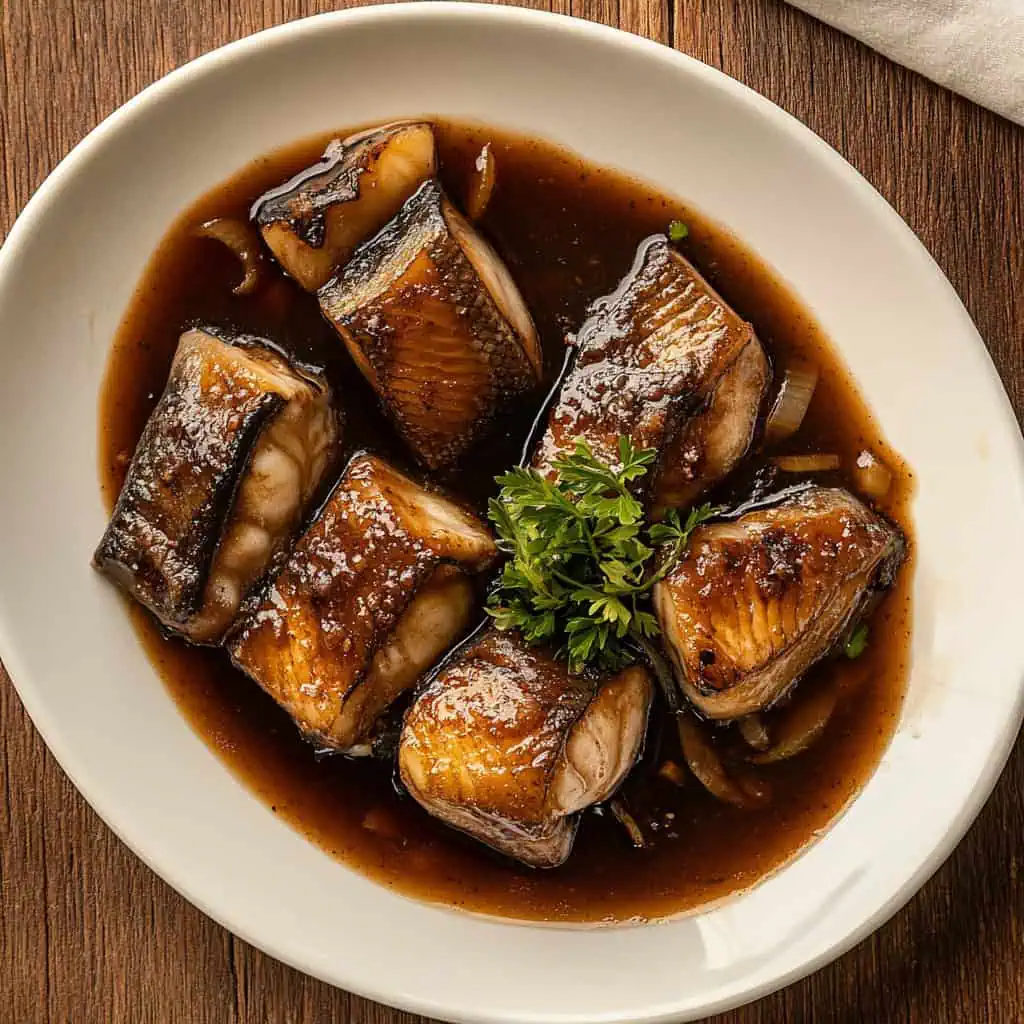









Comments
No Comments